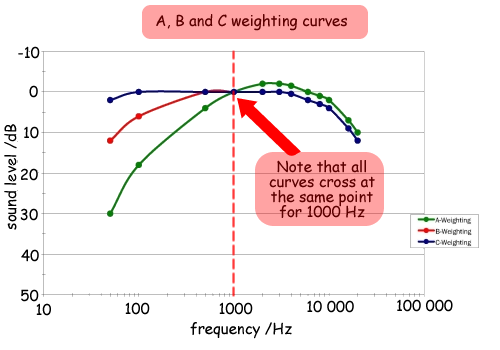dBa and dB scale The ear is capable of hearing a very large range of sounds: the ratio of the sound pressure that causes permanent damage from short exposure to the limit that (undamaged) ears can hear is more than a million. To deal with such a range, logarithmic units are useful: the log of a million is 6, so this ratio represents a difference of 120 dB. Psychologists also say that our sense of hearing is roughly logarithmic. In other words, they think that you have to increase the sound intensity by the same factor to have the same increase in loudness. Whether you agree or not is up to you, because this is a rather subjective question. The dB(A) scale is an adapted dB scale - it gives relative measurements. There are also dB(B), and dB(C) weightings. These symbols are often used to denote the use of different frequency weightings used to approximate the human ear's response to sound, although the measurement is still in dB. Other variations that may be seen are dBA or dBA. The dB scale just measures pure sound intensity levels.
Sound detectors can be adjusted to read either the dB or dBA scale.The most widely used sound level filter is the A scale, which roughly corresponds to the inverse of the 40 dB (at 1 kHz) equal-loudness curve. Using this filter, the sound level meter is thus less sensitive to very high and very low frequencies (mimicing the behaviour of our ears). Measurements made on this scale are expressed as dBA. The C scale is practically linear over several octaves and is thus suitable for subjective measurements only for very high sound levels. Measurements made on this scale are expressed as dBC. There is also a (rarely used) B weighting scale, intermediate between A and C. All are made so that 1 kHz is the same on each scale. If a detector is set to 'read dB' it just records the output as the intensity detected at the sensor. If it is set to read dBA it adjusts that output to take into account the way the human ear detects sound. Therefore it would read at a lower value for the frequencies that the ear cannot detect with ease - it compensates for the variation in frequency response of the human ear. The shape of the output for a dB detector is therefore not frequency dependent - it is a flat response at all frequencies whereas the dBA output varies across the frequency range - look at the loudness perception page for the graph shape for dBA response! At 1kHz the dB
response and dBA response are set to be identical - at other frequencies there
is a difference. Between 1kHz and about 6 kHz the ear is more sensitive than it is at 1kHz - for all other frequencies it is less sensitive than it is at 1kHz
|
Follow me...
|






